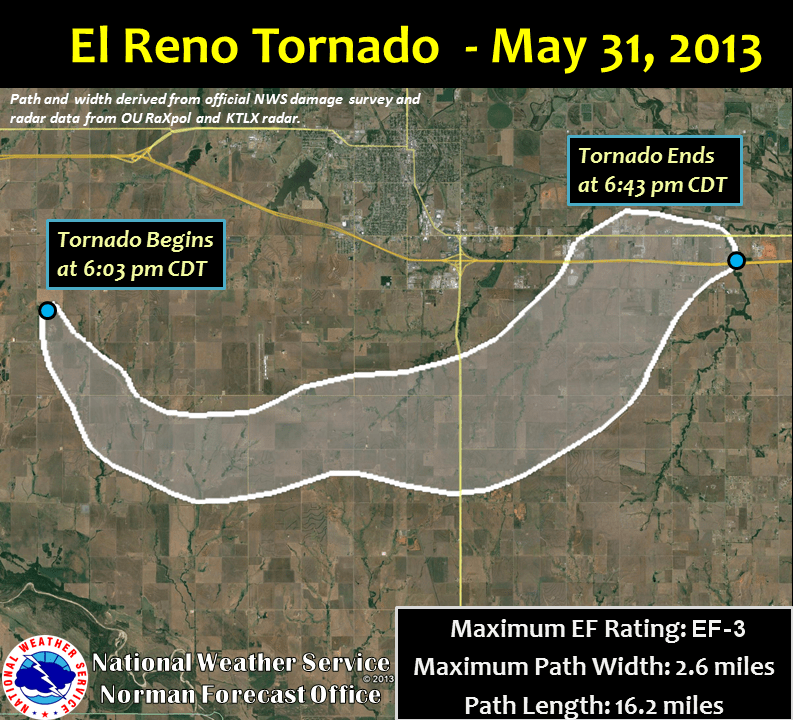SIOUX CITY, Iowa (KCAU) — The width of 46 football fields. That’s roughly the width of the massive tornado that struck El Reno, Oklahoma on May 31, 2013. 2.6 miles wide, to be exact.
The El Reno tornado struck less than two weeks after a devastating EF5 tornado struck an area just 30 miles east-southeast of Moore, a suburb of Oklahoma City, causing devastation.
Late in the afternoon of May 31, 2013, at 6:03 PM CDT, the tornado made landfall west of El Reno and began moving southeast at 20-25 mph. At the same time, the tornado began to grow in size. As it passed just south of the El Reno Municipal Airport, it began to pick up speed, now moving at speeds of 30-45 mph, and continued to grow, with several satellite tornadoes briefly spotted to the west of the larger tornado.

Then, at 6:19 PM CDT, a large wedge-shaped tornado crossed US Highway 81, suddenly turned north and accelerated, swirling through a primarily rural area south/southeast of El Reno while traveling at over 50 mph.
Between 6:24 and 6:26 PM CDT, the long-traveling tornado reached a peak width of 2.6 miles and maximum intensity, with the worst damage occurring in the mostly rural areas affected, and its intensity consistent with an EF3.
Read more about tornadoes here
However, research teams from both the University of Oklahoma’s RaXPol radar and the Severe Weather Research Center’s Doppler on Wheels sampled the tornado and obtained high-resolution data in its vicinity. This data recorded wind speeds of over 200 mph near the ground inside the tornado. The RaXPol radar also measured winds of at least 295 mph. However, these strong winds were only present in small sub-vortices within the tornado’s main circulation.
Despite the extreme wind speeds recorded, survey teams only found damage consistent with an EF3, likely due to the large wedge-shaped storm remaining in a sparsely populated, rural area of the county south of the city of El Reno.
The tornado continued to move east, slowing as it approached I-40. According to the National Weather Service in Norman, Oklahoma, between 6:27 pm and 6:35 pm CDT, the large and violent tornado looped just north of I-40, then moved east again, finally dissipating at 6:42 pm CDT near I-40 and Banner Road, east of El Reno.
Tragically, the El Reno tornado claimed the lives of eight people, including severe weather researcher Tim Samaras, who was well known and respected in the meteorological community for his field work on severe weather and tornadoes, including a research project he was working on called TWISTEX (Tactical Weather Instrument Sampling Experiment). Additionally, his son Paul Samaras and TWISTEX team member meteorologist Carl Young were also killed when the massive tornado suddenly changed direction, accelerated rapidly, and widened as it unexpectedly passed them and threw their car.
Check out more tornado safety and preparedness tips here
Several more people died trying to flee the massive tornado near U.S. Highway 81, and two more died on Interstate 40 waiting for the tornado to pass by.
Many other storm chasers were also struck or had close encounters with tornadoes, but this was mainly due to the size of the tornadoes, combined with their sudden and unexpected changes in direction and speed, which caught many experienced chasers and meteorologists off guard.
In addition to the eight dead, 151 people were injured, including Mike Betts of the Weather Channel and his crew, whose car was hit directly by the tornado, causing the roof to collapse and sending them rolling 200 yards, as well as many other chasers who were similarly injured when they were hit unexpectedly by the tornado.
The El Reno tornado reached a maximum width of 2.6 miles, making it the largest tornado in history, surpassing the previous record-holder, a 2.5-mile wide F4 tornado that struck Hallam, Nebraska on May 22, 2004, just outside the KCAU 9 observation area in Lancaster County.


